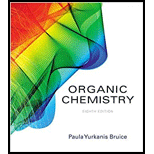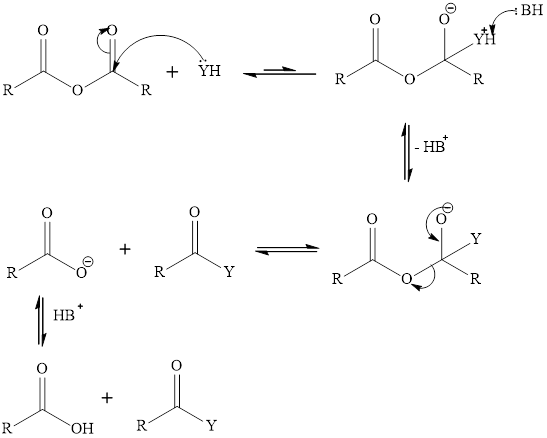
Interpretation:
To predict that out of alcohol, water, and
Concept introduction:
Acid anhydride can react with water, alcohol and amine. When acid anhydride reacts with water it gives two equivalent of

Want to see the full answer?
Check out a sample textbook solution
Chapter 15 Solutions
ORGANIC CHEMISTRY-W/S.G+SOLN.MANUAL
- Which of the following will produce ammonia upon hydrolysis? "NH2arrow_forward6. (Chapter 15-Q37) Indole is an aromatic heterocyclic that has a benzene ring fused to a pyrrole ring. Answer the following questions. Indole 6(a) What is the hybridization of N in this molecule? = 6(b) How many pi electrons N contributes to the ring? = 6() Which orbitals contribute to form a sigma bond between N and H in this molecule? = 6(c) What is the electronic relationship of Indole to naphthalene? Give the answer by comparing number of rings and number of pi electrons in both compounds, write x rings, y pi electrons=|arrow_forwardWhat is Terephthalic acid and how important it is?arrow_forward
- The addition of water to aldehydes and ketones occurs rapidly, although it is not thermodynamically favored. What would be the product for the reaction above? Hint: Think of the self-ionization of water and the polarity of the carbonyl group.arrow_forward(a) Explain how NaBH, in CH;OH can reduce hemiacetal A to 1,4-butanediol (HOCH,CH,CH,CH,OH). (b) What product is formed when A is treated with Ph;P=CHCH,CH(CH),? (c) The drug isotretinoin is formed by reaction of X and Y. What is the structure of isotretinoin? Although isotretinoin (trade name Accutane or Roaccutane) is used for the treatment of severe acne, it is dispensed under strict controls because it also causes birth defects. PPha NaOCH,CH3 HO- isotretinoin HO A Br X Yarrow_forwardSubject-- chemistryarrow_forward
- One acid–base classification defines a base as a substance that acts as a proton (H+H+) acceptor, and is also known as a Bronsted–Lowry base. All bases contain a non‑bonding pair of electrons. In each of the molecules, identify the atom that behaves only like a Bronsted–Lowry base. The atom in compound A that behaves only like a Bronsted–Lowry base is the nitrogen. the oxygen on the carbonyl. the oxygen bonded to hydrogen. the hydrogen bonded to oxygen.arrow_forwardUsing the data in Appendix C, determine which of the following bases is strong enough to deprotonate acetonitrile (CH3CN), so that equilibrium favors the products: (a) NaH; (b) Na2CO3; (c) NaOH; (d) NaNH2; (e) NaHCO3.arrow_forwardAn aqueous solution of a primary or secondary amine reacts with an acyl chloride to form an amide as the major product. However, if the amine is tertiary, an amide is not formed. What product is formed? Explain.arrow_forward
- 2) a) n-Butyllithium is used to deprotonate the following compounds. Draw the structures of the resulting organolithium compounds (assume they are monomeric). Me₂N SO₂ b) Explain the selectivity of deprotonation. c) Each organolithium is reacted with ethyltosylate. Draw the structures of the resulting products.arrow_forwardWhen trans-2-chloro-1-cyclohexanol is treated with a base, cyclohexene oxide is the product. However, when cis-2-chloro-1-cyclohexanol is treated with a base, the product is cyclohexanone. Write the mechanism for each of the two reactions.arrow_forwardThe Brønsted-Lowry definition of acids and bases is: Acids are proton donors, bases are proton acceptors Acids are nucleophiles and bases are electrophiles Acids are proton acceptors, bases are proton donors Carboxy groups are acids and amine groups are bases Carboxy groups are electrophiles and amine groups are nucelophilesarrow_forward
 Organic ChemistryChemistryISBN:9781305580350Author:William H. Brown, Brent L. Iverson, Eric Anslyn, Christopher S. FootePublisher:Cengage Learning
Organic ChemistryChemistryISBN:9781305580350Author:William H. Brown, Brent L. Iverson, Eric Anslyn, Christopher S. FootePublisher:Cengage Learning

 EBK A SMALL SCALE APPROACH TO ORGANIC LChemistryISBN:9781305446021Author:LampmanPublisher:CENGAGE LEARNING - CONSIGNMENT
EBK A SMALL SCALE APPROACH TO ORGANIC LChemistryISBN:9781305446021Author:LampmanPublisher:CENGAGE LEARNING - CONSIGNMENT Organic Chemistry: A Guided InquiryChemistryISBN:9780618974122Author:Andrei StraumanisPublisher:Cengage Learning
Organic Chemistry: A Guided InquiryChemistryISBN:9780618974122Author:Andrei StraumanisPublisher:Cengage Learning General, Organic, and Biological ChemistryChemistryISBN:9781285853918Author:H. Stephen StokerPublisher:Cengage Learning
General, Organic, and Biological ChemistryChemistryISBN:9781285853918Author:H. Stephen StokerPublisher:Cengage Learning





